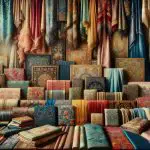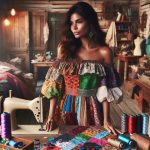You're likely aware that vintage fabrics are making a strong comeback in the fashion industry, blending nostalgic allure with modern sustainability. Designers are now upcycling vintage textiles into eco-friendly pieces that highlight historical beauty. Imagine seeing classic patchwork transformed into contemporary scarves or headbands. Innovations in sustainable dyes, such as natural pigments, are also enhancing these creations, adding both depth and environmental consciousness. Curious about how these retro prints are being revived and what makes these modernized techniques so alluring? There's much more to explore in this fascinating intersection of past and present.
Table of Contents
Key Takeaways
- Retro prints are being modernized with digital printing and contemporary silhouettes.
- Sustainable fabrics like organic cotton and hemp are gaining popularity for vintage-inspired clothing.
- Eco-friendly dye innovations using natural pigments offer unique, rich colors.
- Upcycling vintage textiles into new pieces promotes sustainability and creativity.
- Hybrid sewing techniques blend traditional craftsmanship with modern durability.
Retro Prints Revival
Why are retro prints making such a big comeback in today's fashion scene? It's all about the timeless allure and the endless fashion inspiration they provide. Retro prints, especially floral patterns, evoke a sense of nostalgia while staying stylishly relevant. They offer a unique blend of history and modernity, which many fashion enthusiasts find irresistible.
To master incorporating retro prints into your wardrobe, you need a few essential styling tips. Start by embracing bold colors. Retro prints often feature vibrant hues that can transform any outfit into a statement piece. Don't shy away from mixing and matching different floral patterns; the key is to balance them with solid colors to avoid overwhelming your look.
Layering is another powerful technique. Pair a retro floral blouse with a solid-colored blazer or a bold-colored skirt. This juxtaposition not only highlights the print but also adds depth to your outfit. Accessorizing with vintage-inspired items like scarves or chunky jewelry can further elevate your style.
Sustainable Fabric Choices
As you embrace vintage prints, it's equally important to consider sustainable fabric choices that align with eco-friendly fashion practices. Opting for materials that are both stylish and kind to the planet makes a significant impact. Biodegradable fibers like organic cotton, hemp, and bamboo decompose naturally, reducing environmental waste. Ethical sourcing guarantees that the fabrics you choose support fair labor practices and responsible manufacturing.
To guide your fabric selections, here's a quick reference table:
| Fabric Type | Biodegradable | Ethically Sourced |
|---|---|---|
| Organic Cotton | Yes | Often |
| Hemp | Yes | Often |
| Bamboo | Yes | Sometimes |
| Recycled Polyester | No | Sometimes |
Choosing biodegradable fibers not only benefits the environment but enhances the longevity and comfort of your wardrobe. Organic cotton, for example, is often grown without harmful pesticides, making it healthier for both the planet and your skin. Hemp is incredibly durable and requires minimal water, while bamboo is known for its softness and rapid growth cycle. However, always verify ethical sourcing to make sure your purchases contribute to sustainable and fair industry practices.
Modernized Vintage Techniques
Integrating modernized vintage techniques into your sewing projects can revitalize classic styles with contemporary flair. By blending tradition with innovation, you'll create pieces that are both timeless and trendy.
One way to achieve this is through digital printing. This technology allows you to replicate intricate vintage patterns with precision, ensuring every detail is perfect. Not only does it save time, but it also opens up endless possibilities for customization.
In addition, consider incorporating modern silhouettes into your designs. By updating the shapes and fits of vintage garments, you can make them more relevant to today's fashion standards. For instance, transforming a classic A-line dress into a sleek, tailored fit can offer a fresh take on a beloved style.
Here are three techniques to get you started:
- Digital printing: Use this to recreate and customize vintage patterns.
- Modern silhouettes: Update vintage garments with contemporary shapes and fits.
- Hybrid techniques: Combine hand-sewing with machine stitching for durability and authenticity.
Eco-Friendly Dye Innovations
Harnessing the power of eco-friendly dye innovations can transform your sewing projects into sustainable masterpieces. By incorporating natural pigments and plant-based dyes, you're not only reducing environmental impact but also achieving rich, unique colors that commercial dyes can't replicate. These eco-friendly options allow you to master the art of sustainable fashion.
Here's a quick guide to some popular natural pigments and their sources:
| Dye Source | Color Achieved | Dyeing Method |
|---|---|---|
| Indigo Plant | Deep Blue | Fermentation |
| Madder Root | Red to Pink | Boiling |
| Turmeric | Bright Yellow | Boiling |
Using these plant-based dyes is straightforward. For indigo, you'll need to ferment the leaves to extract the blue pigment. Madder root and turmeric can be boiled to release their vibrant hues. The beauty of these dyes lies not only in their eco-friendliness but also in the depth and complexity of the colors they produce.
Upcycling Vintage Textiles
Breathing new life into vintage textiles can be a rewarding way to create unique, sustainable pieces for your wardrobe. By repurposing treasures from the past, you're not just preserving history; you're also crafting chic items that reflect your personal style and commitment to sustainability.
When you upcycle vintage textiles, consider these creative approaches:
- Patchwork Projects: Combine different fabric scraps to create a one-of-a-kind quilt, jacket, or bag.
- Modern Alterations: Tailor vintage garments to fit current trends or your own measurements, giving them a contemporary twist.
- Accessorizing: Transform vintage fabric into accessories like scarves, headbands, or even statement jewelry.
Mastering the art of upcycling means you'll develop a keen eye for quality materials and timeless patterns. You'll learn to appreciate the craftsmanship of older textiles and discover innovative ways to integrate them into modern designs. Not only will you reduce waste, but you'll also elevate your wardrobe with pieces that tell a story.
Frequently Asked Questions
How Can I Identify Genuine Vintage Fabrics From Replicas?
To identify genuine vintage fabrics from replicas, use authenticity verification methods and replica detection techniques. Examine fabric aging and preservation techniques, focusing on wear patterns, material composition, and historical weaving methods to guarantee accuracy.
What Are the Best Care Practices for Preserving Vintage Fabrics?
Did you know that 70% of fabric damage occurs due to improper care? Utilize proper storage tips and restoration techniques, like acid-free tissue. Employ gentle cleaning methods and preventative measures to maintain your fabric's pristine condition.
Are There Specific Vintage Fabrics Suitable for Different Climates?
You'll find vintage silks perfect for warmer climates with their light, breathable nature, while vintage wools, especially winter tweeds, offer excellent insulation. Tropical prints suit humid environments, adding style and comfort. Choose wisely for climate compatibility.
How Do Vintage Fabrics Compare in Durability to Modern Ones?
When comparing durability, vintage fabrics often outlast modern ones, thanks to their sturdy construction. You can easily detect fabric authenticity by examining the weaving techniques and materials, ensuring you're investing in quality that stands the test of time.
Where Can I Find Rare Vintage Fabrics for Purchase Online?
You can find rare vintage fabrics online through reputable sellers on platforms like Etsy, eBay, and specialized vintage fabric websites. Always check reviews and ratings to make sure you're purchasing from a trustworthy source.
- What Is Pochampally Ikat? a Journey to India’s Silk City - June 27, 2025
- What Is Pochampally Ikat? a Journey to India’s Silk City - June 27, 2025
- What Is Pochampally Ikat? a Journey to India’s Silk City - June 27, 2025







